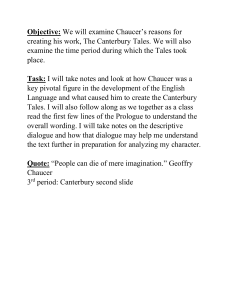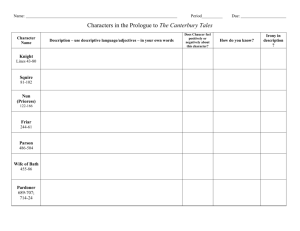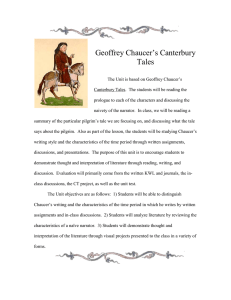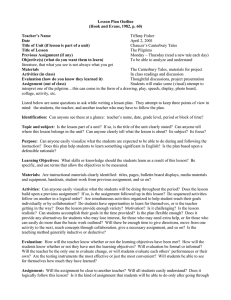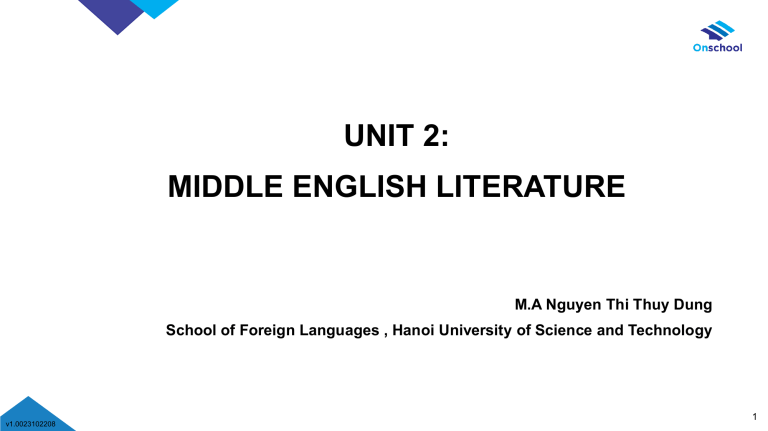
UNIT 2: MIDDLE ENGLISH LITERATURE M.A Nguyen Thi Thuy Dung School of Foreign Languages , Hanoi University of Science and Technology v1.0023102208 1 WARMING UP v1.0023102208 2 OBJECTIVES After the lesson, the students will: • Gain some knowledge about Middle English Literature. • Gain some knowledge about the author Chaucer and his “Canterbury Tales”. • Be able to analyze “The Canterbury Tales” by Chaucer. v1.0023102208 3 OVERVIEW v1.0023102208 2.1 Middle English literature 2.2 The Canterbury Tales by Chaucer 4 2.1. MIDDLE ENGLISH LITERATURE Middle English language - Context • Developments in language. • New structures in society. • Changes in how people viewed the world. => Literature unlike the heroic literature of the Old English period. • 1066: The Norman Conquest => Old English was suppressed, Norman French language was supported. • However, the English language survived among the conquered Anglo-Saxons. • By the 14th century, English reemerged as the dominant language but very different from Anglo-Saxon Old English. • Co-existence of Norman French and the emerging English = Middle English. v1.0023102208 5 2.1. MIDDLE ENGLISH LITERATURE The Norman Invasion and the English Language • 1066: the invasion of the Normans => The French of Normandy, and Latin was to become the language of court, religion and science. • English: used by common people but no literature written in it for 200 years. => The divergence in language could not last long. • The Normans had to learn some English in order to communicate. Moreover, Norman kings set off to the Crusades in the 12th century, so they had to persuade people to go there. • 100 years after the invasion the descendants of Norman knights spoke French which was unintelligible by the French people. • In 13th century, England lost control of its French territory, and the Norman nobility had to declare allegiance either to France or to England. Many of them chose England, because they were born there. v1.0023102208 2.1. MIDDLE ENGLISH LITERATURE • During the late 13th and in the 14th century, English was making a comeback. • The mood towards France was becoming more and more hostile: it wasn’t seen as a mother country, but as a dangerous rival. Although French and Latin were still languages of prestige, English was becoming the language of communication, even among the nobility. • The Hundred Years’ War with France (mid-14th – mid-15th cent.) marked the definite decline of French and the rise of English as a chief language. v1.0023102208 2.1. MIDDLE ENGLISH LITERATURE • The king-retainer structure of Anglo-Saxon society evolved into feudalism. • Feudalism society organization: clergymen, the noblemen who were granted fiefs by the king, and the peasant class who worked on the fief. • • • • The clergy :those who tended to the spiritual realm and spiritual needs. The nobility: those who ruled, protected, and provided civil order. The commoners: those who physically labored to produce the necessities of life for all three estates. However, by Chaucer’s lifetime (late 14th century), another social class, a merchant middle class, developed in the growing cities. Many of Chaucer’s pilgrims represent the emerging middle class: the Merchant, the Guildsmen, and even the Wife of Bath. v1.0023102208 8 2.1. MIDDLE ENGLISH LITERATURE • The most important philosophical influence of the Middle Ages was the Church, which dominated life and literature. In medieval Britain, “the Church” referred to the Roman Catholic Church. • Although works such as Chaucer’s Canterbury Tales reveal an exuberant, and often bawdy, sense of humor in the Middle Ages, people also seemed to have a sense of the brevity of human life and the transitory nature of life on earth. v1.0023102208 9 2.1. MIDDLE ENGLISH LITERATURE • Outbreaks of the plague, known as the Black Death, affected both the everyday lives and the philosophy of the Middle Ages. • The outbreaks of plague, the Middle Ages were a dangerous, unhealthy time. • Women frequently died in childbirth. • Infant and child mortality rates were high and life expectancies short. v1.0023102208 10 2.1. MIDDLE ENGLISH LITERATURE The Dark Ages (5th to 14th century) • • • • • The fall of Roman Empire. Poverty and Disease and War were common. Lack of scientific and cultural advancement. Feudalism was the dominant political system. Supreme authority was wielded by the Church and the Emperor. → Obscurantism, social oppression. v1.0023102208 11 2.2. THE CANTERBURY TALES BY CHAUCER About the author – Geoffrey Chaucer • Geoffrey Chaucer, (born c. 1342/43, London?, England - died October 25, 1400, London). • The outstanding English poet before Shakespeare and “the first finder of English language”. • His The Canterbury Tales ranks as one of the greatest poetic works in English. • Variety in subject matter, genre, tone, and style and in the complexities presented concerning the human pursuit of a sensible existence. • Showing life as it was. • A great artist and humanist. v1.0023102208 12 2.2. THE CANTERBURY TALES BY CHAUCER Introduction • • • • • Chaucer’s most important work. A collection of stories in verse told by people of different standing. A collection off 24 stories. The stories are preceded by a prologue. Short prologues to each story connect them in one work. v1.0023102208 13 2.2. THE CANTERBURY TALES BY CHAUCER Introduction (cont.) • In the prologue to the tale, Chaucer tells that one April evening, a group of pilgrims comprising all kinds of people gathered at the Tabard Inn, just outside London. After the supper, aiming at reducing the tedium of the journey, the innkeeper proposed a plan: each pilgrim would tell two stories on the way to Canterbury and two on the way back. He who was the best storyteller would be offered a free supper at the Tabard Inn. The Innkeeper would act as the judge himself. • The next morning, sunny and beautiful, the pilgrims, with Harry Bailey the innkeeper and Chaucer, 30 in all, set out to Canterbury. v1.0023102208 14 2.2. THE CANTERBURY TALES BY CHAUCER • First great work in verse in English literature. • A vivid picture off English society: each of his characters was given as an individual, typical of his country and his time. • A variety of characters: a doctor, a merchant, s student from Oxford, a carpenter, a miller, a lawyer, a sailor, a cook, some women, monks and a pardoner. • Telling the stories according the pilgrims’ rank of standing. The miller - a fabliau, the pardoner - a moralizing tale. v1.0023102208 15 2.2. THE CANTERBURY TALES BY CHAUCER • Watch a short video of “The pardoner’s tale” – “Three Young Men, Death and a Bag of Gold” and answer some questions below: 1. How many characters are there? Who are they? 2. How did the young men learn about the death of their friend? 3. What did they decide to do? 4. What made the young men forget about Death? 5. What happened to the young men at the end? • Video: Link v1.0023102208 16 2.2. THE CANTERBURY TALES BY CHAUCER Summary: Here are the contents of the pardoner’s tale “Three young men, Death and a bag of gold”: Three young men were drinking at an inn when a funeral passed by. “Who is dead”? They asked and were told that it was a young man just like themselves. At first, they could not believe it, but the innkeeper told them: “Yes, it’s quite true. The Traitor Death has killed this year all the men, women and children. One might think that Death lived in that village”. v1.0023102208 17 2.2. THE CANTERBURY TALES BY CHAUCER Summary (cont.): The innkeeper was probably speaking of a village where the plague had carried away all the inhabitants. But the young men were a little drunk and they understood that Death really lived not far from the inn where they were drinking wine. And so they cried: "Since Death is such a wicked traitor and has killed our friend, let us go and kill Death. But before we go, let us join hands and promise we shall help each other and be as brothers until we find and kill Death". So they joined hands and promised to be true to each other, and set out. Very soon they met an old man on the road and asked him: “Do you know where we can find Death?“, "Why, yes", said the old man, "I just saw him in that little wood over there. Do you see that big oak-tree? You will find him just under It“. v1.0023102208 18 2.2. THE CANTERBURY TALES BY CHAUCER Summary (cont.): When the three young men heard that, they ran till they reached the tree, and under it they found a large bag of gold. Then they forgot all about Death – they were so glad to have found so much gold. They sat down by the bag and the youngest of them said: "We shall now lead a jolly life and spend all this gold. But first we must carryit home, and that we must do by night, when no one can see us. If people see us they may try to rob us, or they will ask us where we took all that gold, and when we tell them, they will not believe us and think we have stolen it. So till nightwe must wait here and guard the gold. It is still long till night and we shall soon be hungry. Let one of us go back to town and fetch some wine and food. The other two will stay here and guard the gold". They agreed to do so and the youngest was sent for the wine and food. v1.0023102208 19 2.2. THE CANTERBURY TALES BY CHAUCER Summary (cont.): When the youngest had gone, one of the two who were left to guard the gold, said:“ Why should we divide this gold between three, when we might divide between two?” “How’s that?” asked the second man. “Why?” said the first "two are stronger than one. When he comes with the wine and sits down, you will pull him down and struggle with him as if you were playing and then I shall stick my knife deep into his side". And so these two decided to kill the third. Meanwhile this third was thinking on his way to town: “How I should like to have all the gold for myself!” And then he thought he would buy poison and kill both his friends. He bought three bottles of wines. put poison in two - the third he kept pure for himself - and went back to the oak-tree. v1.0023102208 20 2.2. THE CANTERBURY TALES BY CHAUCER Summary (cont.): The two other men killed him just as they had decided. And Then said the first of them when this was done: "Now liar a drink. Sit down and let's be merry, For later on there’ ll be the corpse to bury”. And as it happened, reaching for a sup He took a bottle full of poison up And drank; and his companion, nothing loth, Drank from it also, and they perished both. Thus this two murderers received their due, So did the treacherous young poisoner too. v1.0023102208 21 2.2. THE CANTERBURY TALES BY CHAUCER Comprehending the pardoner’s tale 1. How many characters are there? Who are they? 2. How did the young men learn about the death of their friend? 3. What did they decide to do? 4. What made the young men forget about Death? 5. What happened to the young men at the end? v1.0023102208 22 2.2. THE CANTERBURY TALES BY CHAUCER Comprehending the pardoner’s tale (answer) 1. The main characters are the three young men. An important minor character is Death 2. Three young men were drinking at an inn when a funeral passed by. “Who is dead”? They asked and were told that it was a young man just like themselves. At first, they could not believe it, but the innkeeper told them: “Yes, it’s quite true. The Traitor Death has killed this year all the men, women and children. One might think that Death lived in that village”. 3. They decided to find Death and kill him. They joined hands and swore a solemn oath that they would be brothers in any circumstances 4. The bag of gold. 5. All of them died because everyone planned to kill the others for the gold. v1.0023102208 23 2.2. THE CANTERBURY TALES BY CHAUCER Analyzing the pardoner’s tale 1. Find details in the story to prove that the three young men were not real friends. 2. What are the themes of the pardoner’s tale? 3. What is Chaucer satirizing in the pardoner’s tale? 4. What is the moral of the pardoner’s tale? 5. What do you think “the old man” and “gold” symbolize? v1.0023102208 24 2.2. THE CANTERBURY TALES BY CHAUCER Analyzing the pardoner’s tale (answer) 1. Three young men were drinking at an inn when a funeral passed by. The two older men decided to kill the third: “Why should we divide this gold between three, when we might divide between two?”, "two are stronger than one. When he comes with the wine and sits down, you will pull him down and struggle with him as if you were playing and then I shall stick my knife deep into his side“. The youngest man bought poison and killed both his “friends”. 2. Greed and hypocrisy 3. Being drunk, human’s greed and hypocrisy 4. You reap what you sow, greed is the root of all evil 5. The old man – Death in disguise, gold – materialism and human’s greed v1.0023102208 25 SUMMARY The lesson covers some main points: • The context the Middle English literature. • The Canterbury tales by Chaucer. • A summary and an analysis of the story: Three young men, Death and a bag of gold. v1.0023102208 26


